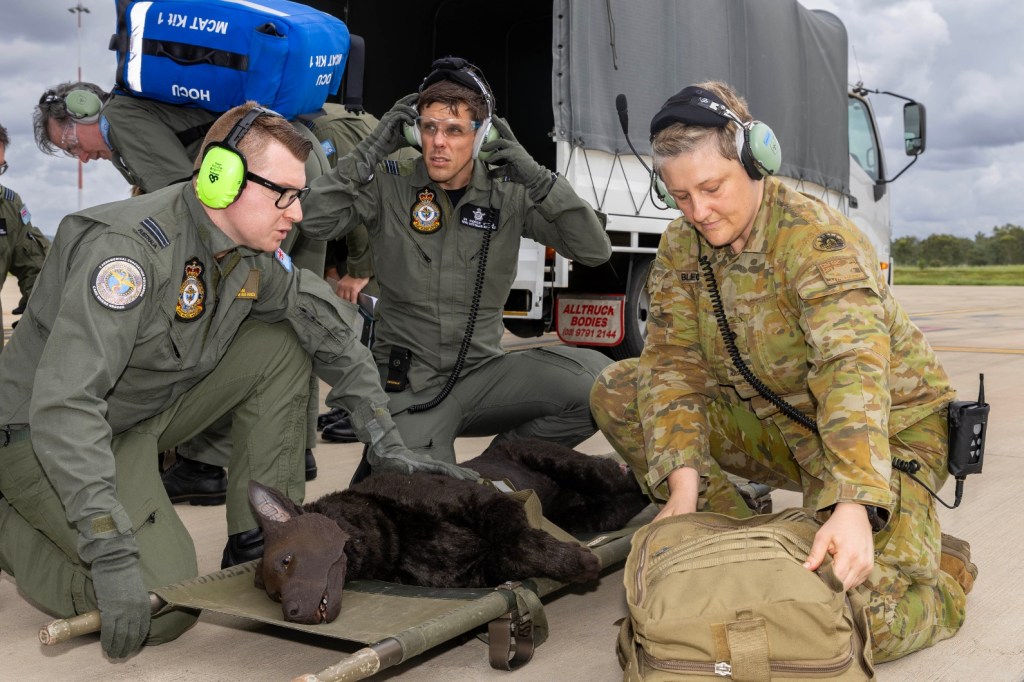
If there’s one job arguably more dangerous and far worse paid than that of an Australian Army Sapper, whose job it is to locate and disarm hidden bombs and improvised explosive devices, it’s that of their four-legged munitions-sniffing friends, the military working dog.
And when things go wrong, and they certainly can and do go wrong, there’s an obvious question as to what to do about the canine member of the team that, if they survive, is usually seriously injured along with their two-legged teammate.
That real-world ethical and logistical dilemma is one step closer to being solved after the Royal Australia Air Force (RAAF) revealed it’s now using highly experienced vets to teach canine critical care to medivac teams so they can fly out dogs as well as their handlers in cases of copping a blast.
It might sound a little strange, but the bond between Sappers and their working dogs — as most dog lovers will attest — is closer to a family member than a workmate, so it makes sense the paws don’t get left behind.
Registered full-time vet Captain Alexandra Blecich is one of those teaching medics how to minister to wounded dogs in the field with the resources they have to hand while also treating humans.
Part of Headquarters 2nd Health Brigade, Blecich helps skill military medics on what drugs to use on dogs, the handling dogs under anaesthesia, and how to best put a dog on a stretcher.
Like a lot of battle scenario prep, it’s part training/part science/part improvisation. It turns out human stretchers are not that great for the humble hound.
“We found the stretcher configurations were not suitable for a dog,” Blecich said. “The stretcher pole places pressure on an injured leg, prompting us to improvise with a work table padded with a mat.”
The solution using existing resources is likely to win plaudits at the Defence Materiel Organisation and Defence Finance.
“This solution eliminated the need for purchasing additional equipment,” Blecich said.
But there is some very bespoke canine training equipment, not least a full-size mannequin of a dog that acts in the same way a wounded animal would.
“The mannequin is a great training aid to rehearse on. If you don’t fit the canine-specific tourniquet correctly, the dog will continue to bleed,” Blecich said.
“Captain Blecich is believed to be the first veterinarian officer to participate in a military critical care aeromedical evacuation team (MCAT) scenario at RAAF Base Amberley, where she worked with personnel from the Health Operational Conversion Unit and 3 Aeromedical Medical Evacuation Squadron,” Defence said.
On previous operations, it seems Australia has fallen back on military vets from other allies to provide canine critical care, whose critical care teams had veterinary training.
Group Captain David Cooksley, clinical director for emergency and aeromedical evacuation at Headquarters Health Reserves Branch, took an interest in canine care after he observed other nations took their dogs out with their troops, and that “their clinicians were expected to provide care and transport for injured dogs on the battlefield,” Defence said.
“I was inspired to learn how to care for dogs as a human healthcare provider and start developing our military working dog pre-veterinary care and aeromedical evacuation capability,” Cooksley said.
“These are valuable serving members and we have a legal and moral responsibility to provide them appropriate medical support.”
READ MORE:
Four legs on the front line as ABF welcomes new detector dogs

